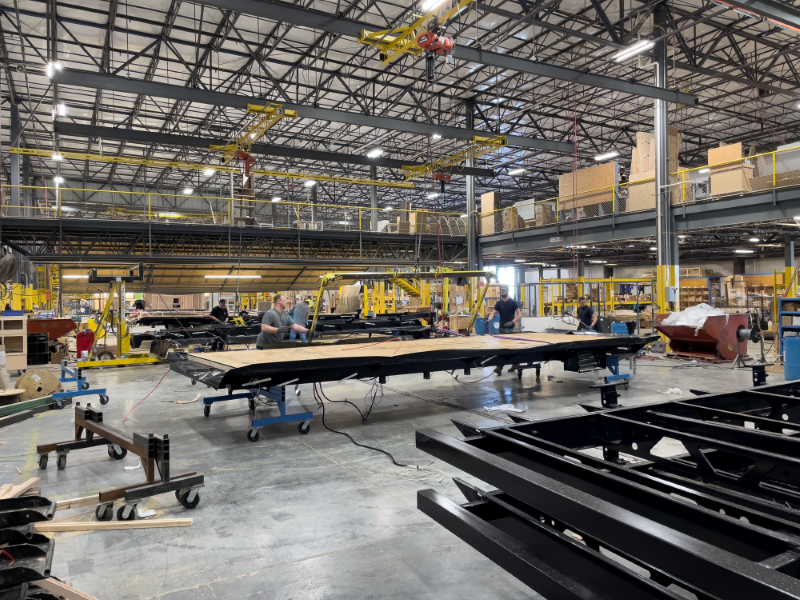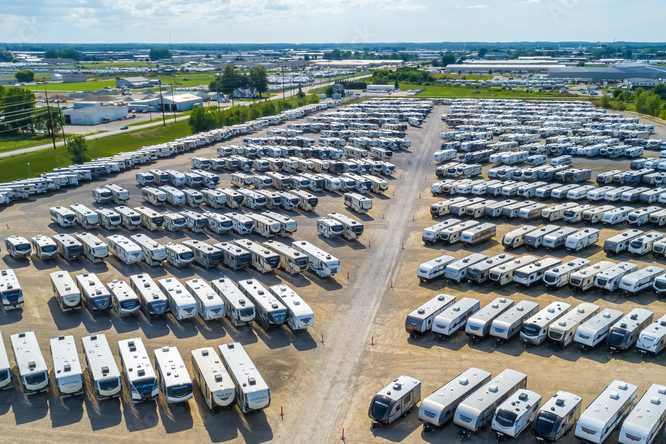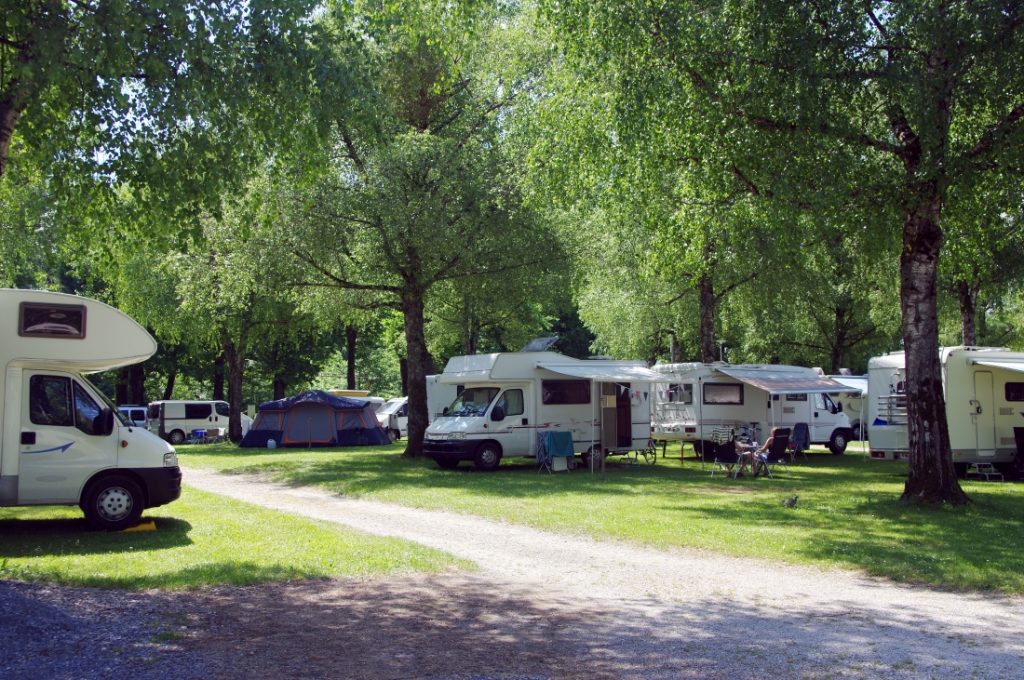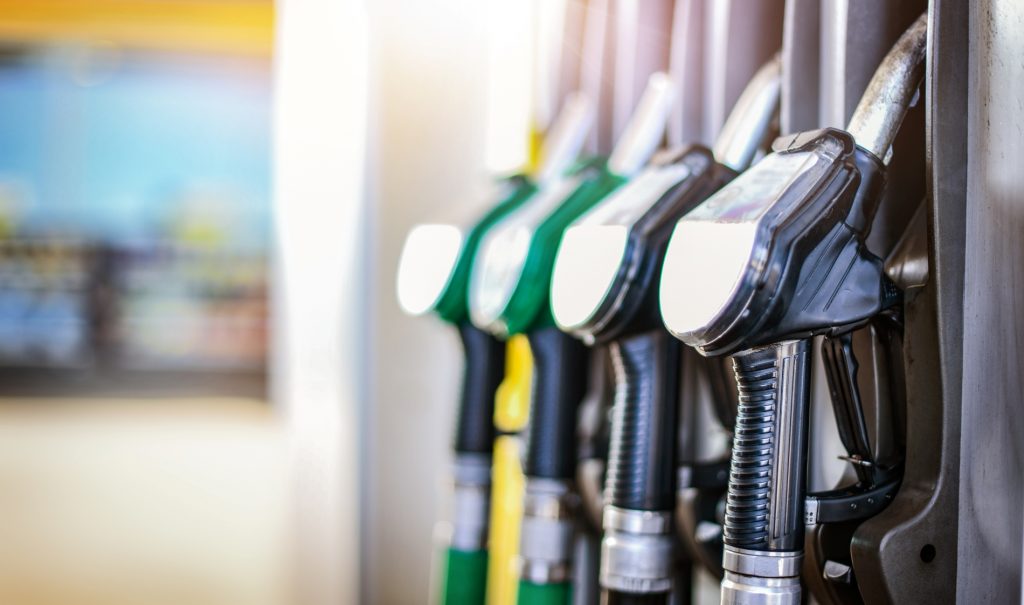Introduction
The RV industry is currently experiencing significant shifts and challenges that are shaping its future.
As we delve into the latest statistics and trends, it becomes apparent that a virtual “bloodbath” may be on the horizon. In this article, we will explore a range of factors influencing the RV industry, including manufacturing trends, inventory management, pricing strategies, and dealership consolidation.
While some of these developments may pose challenges, they also present unique opportunities for consumers and industry players alike.
Manufacturing and Shipment Trends: To build or not to build
To gauge the health of the RV industry, a crucial indicator is the number of RVs being built and shipped to dealerships.
Recent data reveals a stark contrast compared to the same period last year, with approximately 50% fewer RVs being produced and shipped. This significant decline can be attributed to varying market conditions and the presence of excess inventory in some dealerships.
It’s important to note that RV shipments and sales are not synonymous, although they often correlate. Nevertheless, it is evident that RV sales have not matched the strong figures of the previous years. While this may seem alarming, it requires careful interpretation and analysis.

The Impending Reckoning: Slow the flow
The term “bloodbath” may sound aggressive, but it alludes to an impending reckoning in the RV industry. Analyzing national inventory data across North America, we discover a wide range of situations.
Some manufacturers have an overwhelming percentage of their active inventory comprised of 2022 models, with 2024 models on the horizon. This inventory composition, combined with potentially inflated pricing and the forthcoming model year change, could lead to a significant devaluation of existing stock.
Consequently, certain manufacturers and smaller dealerships may face substantial challenges.
Consumer Opportunities: Strike while the iron is hot
Amidst the potential challenges, there is a silver lining for consumers. Many dealerships are offering new RVs at prices below cost, effectively selling them at a loss.
This provides an excellent opportunity for customers to acquire brand-new RVs at remarkably affordable prices. However, the pressure caused by existing inventory backlog can lead some dealerships to delay replacing units, hindering the manufacturing chain.
Consequently, manufacturers may seek new dealership partnerships to ensure continued production and sales.
Manufacturers’ Response: Discontenting at best
Recognizing the need for more affordable options, manufacturers in Elkhart County, Indiana—the epicenter of the RV industry—have embraced the concept of “discontenting.” This involves streamlining and simplifying RV models to reduce costs while maintaining quality and functionality.
Manufacturers are exploring different approaches to achieve this goal. Some are removing features from existing models, which may result in an unfinished appearance and compromise customer satisfaction. Others have completely reset their product lines, adopting a back-to-basics approach that aligns with market trends.
The preferred approach, however, involves creating new subsets or mini-series of floor plans specifically designed to offer essential features without unnecessary frills. This allows for intentional and clean design, ensuring customers feel satisfied with their purchase.
Dealership Consolidation and Challenges: Who will survive
Smaller dealerships are particularly vulnerable in the current market, as prolonged inventory holding can have a more significant impact on their financial stability. Conversely, larger dealerships with substantial resources can weather the storm more effectively.
Consequently, smaller stores struggling to sell their inventory may face challenges and consider consolidation options.
The declining value of these stores presents an opportunity for larger dealership groups to acquire them.
In fact, a prominent RV dealer group recently announced plans to add nearly one hundred stores to its portfolio, reflecting the ongoing trend of dealership consolidation.

The Changing Landscape of the RV Industry: Trends and Insights
The RV industry is experiencing a period of transformation, reminiscent of similar shifts in other industries like automotive and hospitality. In this article, we will explore the current state of the industry, the impact on the used RV market, upcoming changes in manufacturing, and notable developments from leading manufacturers. Join us as we delve into the dynamics shaping the world of recreational vehicles.
- Shifting Tides in the Used RV Market: In recent months, there has been a notable surge in the volume and value of used RVs entering the wholesale auction market.
This increase can be attributed to the delivery of new RV orders placed during the show season. As dealerships receive new inventory, they are trading in older models, resulting in a higher availability of late-model, lower-mileage used RVs.
While this influx expands options for buyers, it does not necessarily translate to significant price reductions. However, those looking to trade in their RVs can benefit from the current strong resale values.
- The Evolution of Manufacturing: As the industry approaches the model year change to 2024, manufacturers are preparing to introduce updated models.
Some manufacturers have already begun labeling their products as 2024 models, although they may not feature significant changes initially.
The transition to the new model year typically occurs around June, with full implementation of model updates by August.
With many manufacturers focused on existing inventory, details about future plans remain limited. However, staying informed through regular updates from reliable sources will provide insights into upcoming changes.
- Alliance RV’s Expansion into New Market Segments: Alliance RV, known for its fifth wheels, has made a notable foray into the travel trailer market with its Delta series.
This move allows consumers with smaller vehicles and budgets to experience Alliance RV’s innovative features.
The Delta series offers unique offerings, such as dual air conditioners on 50-amp service, advanced front pass-through compartments, and power-saving technologies. Alliance RV’s commitment to innovation positions them as a company to watch in the industry.
- Brinkley RV: A New Player with Ambitious Plans: Brinkley RV has recently emerged as a prominent manufacturer, expanding rapidly and defying industry trends. With their own production facilities, they have designed an optimized manufacturing process that prioritizes efficiency and scalability.
Their ability to build multiple copies of a standardized factory layout allows for smoother transitions and enhanced flexibility.
While their plans for the future include entering the smaller fifth wheel and travel trailer markets, their current growth trajectory is a testament to their commitment to innovation and expansion.
- The Potential for Market Consolidation: In a market where Forest River and Thor dominate most RV production, Brinkley RV’s announcement of its intention to become a consolidator manufacturer is noteworthy.
The industry has limited major players, with only a few independent manufacturers like Alliance RV making their mark.
The potential entrance of a new consolidator could introduce more competition and benefit consumers and the industry. The evolving dynamics in the RV manufacturing landscape will be worth keeping an eye on.
- Cougar’s Resilience and Expansion: Despite an overall decline in fifth wheel sales, Cougar has managed to buck the trend and achieve a growth of 1.5%.
They have received multiple accolades, including consecutive gold-level DSi Awards.
Cougar’s success can be attributed to their commitment to maintaining higher trim offerings while introducing the more affordable Cougar Sports series.
Their ability to adapt to market demands and expand into new price points positions them as a formidable player in the industry.
- Manufacturer-Supported Education: A Step Towards Empowered Owners Recognizing the importance of educated and informed owners, manufacturers like Jayco have introduced online educational platforms. Jayco University has been well-received, prompting the expansion
Camping Popularity: Where will it stop?
The popularity of camping and RV travel has soared in recent years, leading to a surge in demand for campsites.
However, this increased demand has created several challenges for campers seeking the perfect getaway. In this article, we will delve into the issue of campground congestion and explore the factors contributing to this phenomenon.
We will examine survey results, industry data, and discuss potential solutions to alleviate the strain on the camping infrastructure.
Additionally, we will touch upon the current trends in gas prices and how they might influence summer travel plans. So, if you are an avid camper or someone contemplating an RV adventure, read on to gain valuable insights into the current camping landscape.

Campground Congestion: A Growing Concern
As more people embrace the joy of camping, the availability of suitable campsites has become a pressing concern. A recent survey revealed that 42% of respondents felt there weren’t enough camping options, forcing them to look for campsites farther away from their preferred locations. Furthermore, 38% of campers expressed frustration with having to drive long distances to find suitable campsites. This situation has been exacerbated by the fact that 26% of respondents reported that campgrounds have become increasingly crowded.
Surprisingly, the rising cost of camping sites was not among the top concerns mentioned by campers in the survey. However, it is worth noting that campground rates have significantly increased in recent years, adding financial strain to campers’ budgets. Despite these challenges, campers have shown resilience, with many choosing to retain their RVs and continue camping rather than exiting the market as anticipated.
Campground Owners Respond
Recognizing the need to address campground congestion, campground owners and property managers have taken various measures to alleviate the strain.
Approximately 43% of campground owners and property managers plan to extend their camping seasons, increase the number of available sites, or implement a combination of both strategies.
However, expanding campground facilities and creating new campsites is a time-consuming process that involves numerous permits and regulatory hurdles, leading to delays in meeting the growing demand.
The Rising Cost of Camping: Pay to Play
Alongside the challenges of campground congestion, the cost of camping has also seen a significant increase in recent years. As demand rises, campground owners have adjusted their pricing structures accordingly.
While this is understandable from a business perspective, it puts additional financial pressure on campers. Many enthusiasts find themselves paying considerably more for the same camping experience than they would have just a few years ago.
The rising cost of camping adds to the overall challenges faced by campers seeking affordable and accessible options.
Gas Prices: A Potential Silver Lining
Despite the challenges mentioned, there is a glimmer of hope for campers this summer. Gas prices, which often play a significant role in travel decisions, have shown a downward trend.
The average price per gallon of regular unleaded gasoline is currently around $3.57, marking a noticeable decrease compared to the previous year.
While this price is still relatively high, the downward drift provides some relief to travelers who depend on their vehicles for camping trips.

Conclusion
The RV industry is undergoing significant changes and challenges, but also offering opportunities. While RV production and sales have declined, consumers can take advantage of affordable prices.
Manufacturers are streamlining models and creating new subsets to meet market demands. Smaller dealerships may face difficulties, while larger ones are better positioned to weather the storm.
The used RV market is expanding with more options for buyers. Campground congestion is a concern, but campground owners are taking measures to address it.
Rising camping costs pose challenges, but gas prices are providing some relief. The industry’s ability to adapt and meet consumer needs will be crucial for its success.
